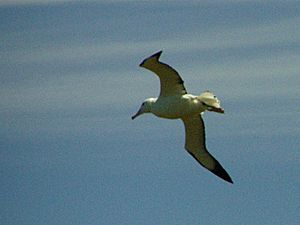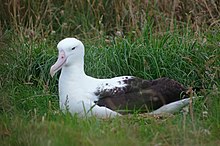King albatross
| King albatross | ||||||||||
|---|---|---|---|---|---|---|---|---|---|---|

Northern king albatross ( Diomedea epomophora sanfordi ) |
||||||||||
| Systematics | ||||||||||
|
||||||||||
| Scientific name | ||||||||||
| Diomedea epomophora | ||||||||||
| Lesson , 1825 |
The Königsalbatros ( Diomedea epomophora ) is divided into two subspecies, the Northern Königsalbatros ( D. e. Sanfordi ) and the Southern Königsalbatros ( D. e. Epomorpha ). With the wandering albatross ( D. exulans ), it is one of the largest long-haul fliers in the world.
Appearance
This species grows to between 120 cm and 130 cm and reaches a wingspan of 330 cm. It weighs about 7 kg. The northern subspecies has dark elytra, while the southern occurrences have gray to pure white elytra. In flight you can see the dark trailing edge of the lower wing. The beak is slightly pink in color and has a narrow, black beak sheath.
distribution
The northern subspecies breeds south of New Zealand on the Chatham Islands and on a mainland colony on New Zealand's South Island - on the Otago Peninsula . On the open sea they are common in the sea area between the Bounty Islands and the Chatham Islands . The southern subspecies breeds on Campbell Island and the Auckland Islands (e.g. on Enderby Island ). Their migrations and foraging flights take the birds to sub-Antarctic waters and the waters around New Zealand. They are also common in the sea area between the Auckland Islands and Macquarie Island , as well as between Dunedin in New Zealand and the Chatham Islands. Both species breed on Macquarie .
Breeding biology
Long-term observations have shown that the king albatross can live to be over 60 years. Fledglings stay at sea until they are four or five years old, when they reach sexual maturity.
The young people who have returned form loose associations, go foraging alone or together and, at home at the colony, advertise the female sex with elegant flight maneuvers. Once they have found a partner, they usually stay together for a lifetime. They do not begin to breed successfully for the first time until they are 6–10 years old.
In September the first pairs arrive at the colony to start a new breeding season. After mating in October, a grass nest is built in November in which the only egg is laid. Immediately after laying the eggs, the male takes over the nest. This change in breeding now happens approximately every seven days. The chick hatches at the end of January / beginning of February and is looked after intensively by both parents for a further two months. Until August, the parents feed their flightless offspring, who spend most of the time alone in the nest exposed to wind and weather. An older young animal can eat up to 2 kg of food per feeding. Only from the beginning of August, one month before they fled, this amount is reduced and the young bird begins to try out its wings. Strong spring winds help him to leave the colony in September and only return in 4–5 years. The parents spend the coming year foraging for food before starting a new breeding cycle.
food
The diet consists mainly of fish and squid on the surface of the water.
Danger
Foraging is one of the reasons albatrosses are threatened by longline fishing . Fish bait floating too long on the surface, especially in daylight, attracts the birds, which get caught on the hook and are drowned in this way.
Most of the casualties are caused by natural predators such as seals and killer whales .
Today the total population of the Southern King Albatross is around 28,000 specimens. The species is listed as Endangered on the Red List of Endangered Species .
literature
- Geoff Moon: The Reed Field Guide to New Zealand Birds. Revised edition. Reed Books, Auckland, NZ 1998.
- James McQuilken: The Mists of Time . Spitzbergen.de, Nov. 2012
Web links
- Royal Albatross Center
- Diomedea epomophora in the endangered Red List species the IUCN 2008. Posted by: BirdLife International, 2008. Accessed January 30 of 2009.
- Videos, photos and sound recordings of Diomedea epomophora in the Internet Bird Collection
Individual evidence
- ^ Galapagos of the Southern Ocean from Dunedin | Polar cruises. Retrieved September 29, 2018 .
- ↑ James McQuilken: The Mists of Time . Ed .: Rolf Stange. 1st edition. Spitzbergen.de, Dassow 2012, ISBN 978-3-937903-15-6 , chap. "Current population trends and threats", p. 137 (Original title: The Mists of Time . Translated by Rolf Stange).
